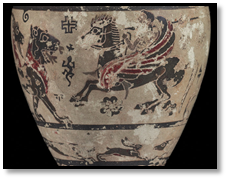The Chimaera of Arezzo

Figure 1 The Chimaera of Arezzo
During a trip to the Getty Villa in Los Angeles, CA, I had the privilege to view the celebrated Chimaera of Arezzo (Figure 1.) The Chimaera of Arezzo, created around 400 BCE, is a fine example of Etruscan bronze sculpture. It is a hollow cast bronze 78.5 cm high and 129 cm in overall length. The tense, roaring monster demonstrates the forcefulness and virtuosity characteristic of Etruscan artisans. The chimaera is a hybrid, three-headed creature having the body and head of a lion, a goat's head attached to its back and a serpent for a tail. The term "chimaera" is believed to come from an ancient pun on the Greek word "chimaira" which means "goat" and the Semitic word "chmar" meaning "fire" or "fiery asphalt" which alludes to the naturally occurring flammable asphalt deposits in Lycia. This chimaera, or "fiery goat" is seen as a personification of the flaming asphalt deposits that naturally occur at Olympus in Lycia in present-day Turkey. (Iozzo)
The chimaera found its way into the epic poetry of Homer's Iliad early in the seventh century BCE as the fierce monster Bellerophon and Pegasus were charged to slay.(Figure 2 & Figure 3) Imagery of the hybrid monster appears to be derived from Near Easter images.(Figure 4, Figure 5, Figure 6 ) The battle of Bellerophon and the chimaera represented the Greek themes of culture over nature, sprit over matter and right over might. The slaying of the fire-breathing monster was a very popular subject for artists throughout Greece. The myth spread into the Italic peninsula and was embraced by the Etruscans by about 450 BCE. (Iozzo)
 |
 |
| Figure 2 Protocorinthian aryballos, ca. 650 BCE | Figure 3 Line drawing of Protocorintian aryballos |
 |
 |
 |
| Figure 4 Human-headed winged bull, Palace of Sargon | Figure 5 Human-headed winged lion (lamassu), 883–859 BCE.; Neo-Assyrian period | Figure 6 Lion sculpture, Archeological Museum, Istanbul |
The chimaera takes its place alongside other great monsters of Greek myth such as Cerberus, the Hydra, the Gorgons, harpies and sirens as a personification of disorder. Slaying the monster represents the freeing of the soul from psychic or spiritual obstacles that prevent the attainment of higher states of being. Bellerophon and Pegasus in combat with the fire-breathing chimaera evolved into Christian images of St. George on his stead, slaying the dragon (Figure 7 ) which came to represent the freeing of the soul from the body or a political allegory of resistance to tyranny. (Battistini)

Figure 7 St George slaying the dragon, Illuminated manuscript 1405-1420
The Chimaera of Arezzo laid buried in rubble, along with a number of small bronze votive figures, for centuries until a new building project unearthed it in 1553. It was immediately claimed by Cosimo I de Medici, the founder of the Medici dynasty and the Grand Duke of Tuscany, as a symbol of Tuscany's Etruscan past. (Iozzo) As such, the Chimaera came to represent the political beasts Cosimo had to tame to create and maintain his realm. (Iozzo) The Chimaera was placed in Cosimo's palace then was moved to the Medici residence of Palazzo Vecchio where it stayed until 1718 when it was moved to the Galleria degli Uffizi. In 1782, Luigi Lanzi, curator of the Galleria, arranged for a new tail to be made to replace the missing piece. In 1870 the Chimaera was then moved to the Royal Archaeological Museum of Florence.
The Getty Villa was a wonderful place to visit while studying ancient Greek and Roman art. The Getty Villa is based on the Villa dei Papiri in Herculenium and houses a large collection of ancient Greek, Roman and Etruscan art. It was a special pleasure to be able to see the Chimaera of Arezzo in person.
Bibliography
Battistini, Matilde. Symbols and Allegories in Art. Los Angeles: Getty Publications, 2005.
Iozzo, Mario, ed. The Chimaera of Arezzo. Firenze: Edizioni Polistampa, 2009.
